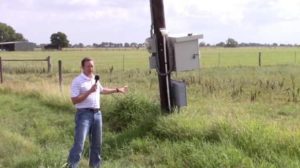What are cathodic protection easements? How should they be located if they’re associated with a pipeline easement across your property? Attorney Philip Hundl answers that question in this video showing several different examples of cathodic protection equipment. Call 800-266-4870 for an appointment or click this link for a no-obligation case evaluation.
Summary of the Cathodic Protection Easements Video
– Hi, I’m Philip Hundl. I’m here at Wharton County, on a property line actually, in a ditch along a county road. We have pipeline crossing here, it’s a Tennessee Gas high pressure gas line, crossing the county road diagonally.
Cathodic Protection Easement Required for Test Leads
I wanted to show today, these pipeline markers. So, we got a pipeline marker, and then also next to it, it’s a cathodic protection test lead. You see that mentioned oftentimes, or you may have seen that in some easement agreements. A cathodic protection test lead is protecting the pipeline, or it’s actually monitoring any corrosion of the pipeline. These are two above-ground appurtenances that can and will be on pipelines.

The location of it is extremely important. We want to make sure that if they’re going to be placed on your property, they’re going to be placed at the property lines, so it’s going to do less… It’s going to obstruct your surface use as little as possible. As you can see, these are located on the property line, actually on the outside of the fence, so it’s not even in the rancher’s pasture. Really important to pay attention to cathodic protection easement terms, and make sure that the location and placement of these are along property lines, or as near to property lines as possible.
Easement Required for Pole-Mounted Cathodic Protection Equipment
Okay, we discussed cathodic protection test leads. Now I’d like to talk about something else that’s oftentimes mentioned in pipeline easement agreements. It’s the cathodic protection equipment, and this is an example of some cathodic protection equipment running near a pipeline. The cathodic protection equipment, I’ve shown some videos on my website already about how cathodic protection equipment works. It works through electricity and changing the current to protect and avoid corrosion, or minimize corrosion in these pipelines.
So, the cathodic protection equipment is going to be on a pole like this wooden pole. Going to have access to power, electricity. The power in this case… There’s a power line, a high-voltage line running across, or it’s a distribution line, electric distribution line, that’s running across the county road, and so this cathodic protection equipment is on this pole, located on the property line. What you want to avoid is having this cathodic protection equipment and this power pole located inside your fence, in a pasture, or inside your fence, or inside your property, if you’ve got a row crop or a rice field. So, you want to pay attention to the location that this cathodic protection equipment, where it will be located, where the poles will be located, where the electric lines that will be feeding this equipment will be located as well, to make sure that they’re less intrusive and less cumbersome to your existing use of the property.
Larger Easement for Multiple Uses
Okay, we’re here. There’s another look at some additional cathodic protection equipment. This is some new cathodic protection equipment that’s just been put in. It’s on its own telephone pole. It has a power source next to it, and then in addition to the cathodic protection equipment on this side, there’s a valve site on this high pressure line, so this an example of how this cathodic protection equipment can be in a field, off the property lines, so therefore encumbering what the landowner or the tenant wants to do on the property. So, this is once again, an example of cathodic protection equipment, much more intrusive than the cathodic protection test leads.
We Can Help You Through the Condemnation Process
Attorney Philip Hundl has helped clients successfully navigate through the condemnation process in cases involving pipelines, high voltage transmission lines, highways, canals and other examples of eminent domain. These videos and this website are intended to help you prepare to meet with your condemnation attorney to make decisions involving your land. To make an appointment with Mr. Hundl, please call 800-266-4870 or click this link for a no obligation case evaluation.
Call 800-266-4870 or text 979-320-9320 for an appointment. We can also arrange for online and telephone appointments all over Texas.